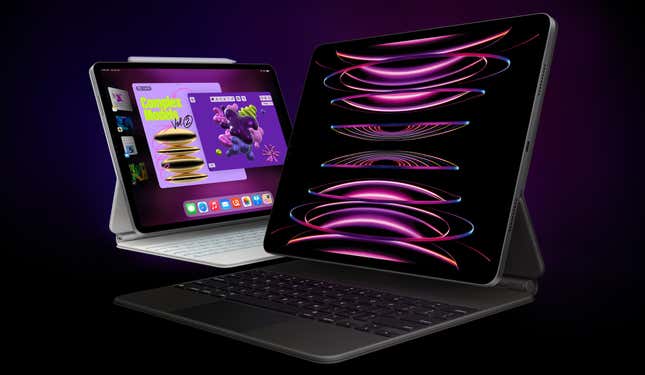
Saving everyone the agony of a six-hour-long presentation, Apple has quietly announced a colorful new 10th-generation iPad with a relocated selfie camera and a sixth-generation iPad Pro upgraded with the company’s M2 chip that debuted in MacBooks earlier this year.

The 10th generation iPad now features the same “all-screen” design as the iPad Pro, the iPad Air, and the iPad Mini. It has a 10.9-inch, 2360x1640 Liquid Retina display surrounded by a thin bezel. The home button is now extinct and replaced with a Touch ID fingerprint sensor on the lock/power button along the top edge of the tablet. Face ID authentication is still not part of the deal, but the 10th-generation iPad is officially the first from Apple to feature the front-facing 12MP ultra-wide selfie camera relocated to the landscape edge of the tablet, improving the calling experience when using services like FaceTime—which work better in landscape mode.

Apple’s proprietary Lightning port is now gone from its modern iPad lineup (although the previous generation iPad with Lightning is still being sold) with the 10th generation iPad moving to USB-C. Powered by the A14 Bionic chip, which first debuted in 2020 alongside the iPhone 12 lineup, the new iPad is far from Apple’s most capable tablet and it’s designed more for casual media consumption instead of as a productivity tool, which is further driven home with stylus support limited to the first generation Apple Pencil.
The 10th generation iPad is available for pre-order starting today (with availability starting on October 26) in four different color options: silver, blue, pink, and yellow. The wifi-only model starts at $449 for the 64GB model, or $599 for the 256GB model, while the wifi + cellular 64GB model is $599, but jumps to $749 with 256GB of storage.

Oddly enough, the new sixth-generation iPad Pro is the least exciting of today’s Apple tablet reveals. It features the same flat edge design that the iPad Pro has been sporting since 2018 and that’s slowly trickled down to Apple’s more affordable iPad models over the years. Unlike today’s new 10th-generation iPad, the iPad Pro staunchly keeps the front-facing camera located on the top edge of the tablet, presumably to prioritize effortless Face ID logins over video chat sessions.

The big news for the new iPad Pro is that it’s been updated with the M2 chip that debuted earlier this year in the 13-inch MacBook Pro and the MacBook Air, keeping the iPad Pro as powerful as the company’s flagship laptops. Apple also announced a new feature for the iPad Pro running iPadOS 16 that allows the 2nd-generation Apple Pencil to be detected up to 12 millimeters above the screen, giving it control over the movement of cursors and brushes before writing or making a stroke. Apple promises this will help improve precision for artists, and it’s a welcome upgrade for anyone looking to transition from Wacom’s drawing tablets to the iPad Pro and Pencil.
The sixth-generation iPad Pro is also available for pre-order starting today (with availability starting on October 26) in silver or space gray finishes and both 11 and 12.9-inch sizes. The 11-inch, wifi-only model with 128GB of storage starts at $799, or $1,099 for the 12.9-inch model. Storage options also include 256GB, 512GB, 1TB, and 2TB capacities, and a maxed-out 11-inch, wifi + cellular with 2TB of storage will set you back $2,099, while a similarly spec’d 12.9-inch model is $2,399.